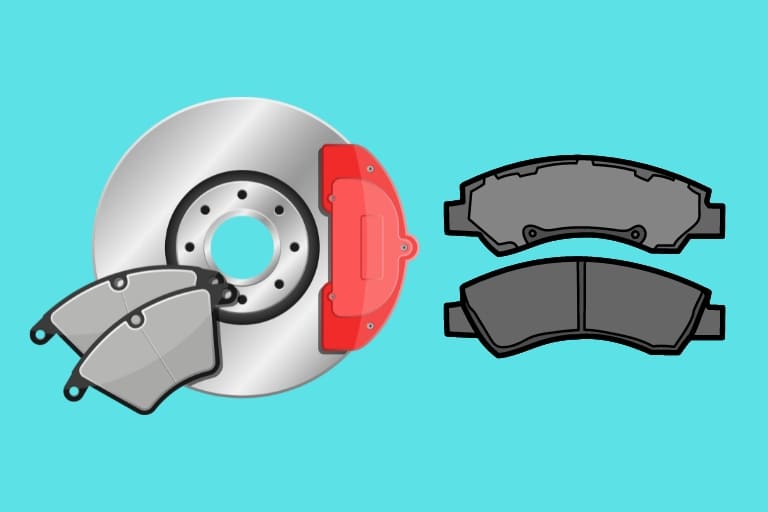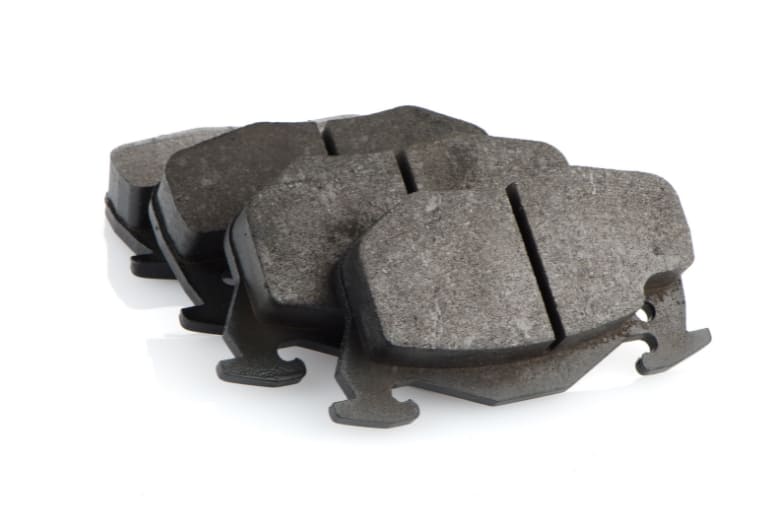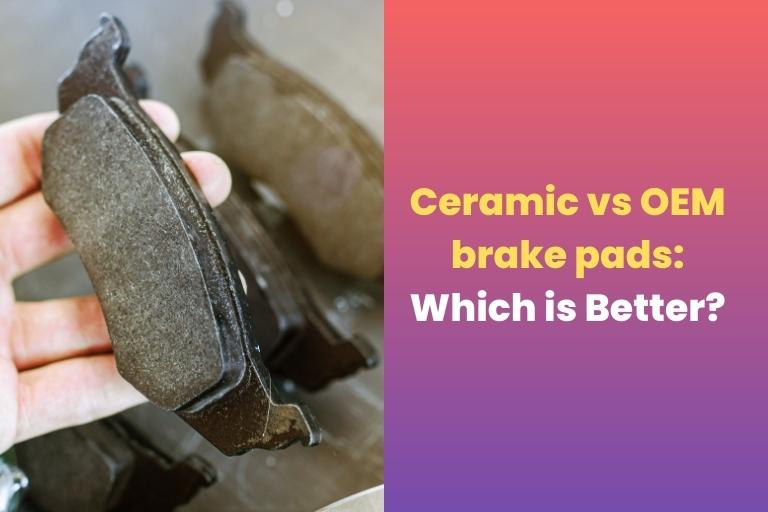As a car owner, you are so concerned about your car and its maintenance. However, when with regard to the braking system, it is critical to choose the finest brake for your vehicle. Selecting brake pads for your car is a big task, as numerous options are available. Ceramic and Original Equipment Manufacturer (OEM) brake pads are two common options among the many available.
In this article, we will examine the construction, function, noise level, dust production, heat resistance, longevity, cost, performance, warranty, and the overall efficacy of ceramic and OEM brake pads.
By the end of this blog, you’ll have a thorough grasp of various brake pad possibilities, allowing you to make an informed decision for your individual needs.
Contents
- 1 Ceramic and OEM brake pads In-depth Comparison
- 2 Factor to consider while comparing Ceramic Brake Pads vs. OEM brake pads
- 3 Comparison Table ceramic brake pads vs. OEM brake pads
- 4 Advantages and disadvantages of ceramic and OEM brake pads
- 5 Which is better Ceramic brake pads or OEM brake pads?
- 6 Frequently Asked Questions
- 7 Conclusion
Ceramic and OEM brake pads In-depth Comparison

Construction
To understand more about the best brake pads that may suit your needs. It is essential to understand its structure since the kind of brake pad that is best for you is entirely reliant on the type of rotors and brake caliper you have, as well as the optimal region of usage. So, let us look at how ceramic and OEM brake pads are made.
Ceramic brake pads are mostly composed of ceramic fibers, with a minor amount of metal and a bonding agent added for structural integrity.
OEM brake pads, on the other hand, are often semi-metallic, including metals such as steel wool, shredded metal wire, and iron powder. Other metals, in addition to a filler, are utilized to link the metallic components together. When the two are compared, ceramic brake pads have a softer and more uniform composition, whereas semi-metallic pads are harsher and have more differences in their composition.
Function
Although both brake pads are constructed differently, ceramic and OEM brake pads serve the same goal and perform the same function.
Both brake pads are required elements of disc brakes, which apply hydraulic pressure to a rotating metal rotor through two pads linked to a caliper.
When you press the brake pedal, the caliper shuts, creating friction and heat when the pad makes contact with the rotor, eventually slowing or stopping the car.
In modern automobiles, disc brakes are often found in the front wheels, offering more stopping force, while drum brakes, which are less costly, are typically used in the back. However, automakers are increasingly offering vehicles with four-wheel disc brakes, which improves overall braking performance and safety.
Factor to consider while comparing Ceramic Brake Pads vs. OEM brake pads

You should have now understood the manufacturing and operation of these two types of brake pads. But what makes them different, and on which one should you rely on if they both provide the same function?
Consider the following criteria when comparing ceramic and OEM brake pads:
- Noise
- Dust
- Heat resistance
- Longevity
- Cost
- Performance
- Warranty
- Overall performance
Let us start the reading and go through each element one by one below:
Noise
Ceramic brake pads
Ceramic brake pads are usually quieter than OEM pads in terms of noise. Because of their composition, which contains ceramic fibers and non-ferrous components, they emit less braking noise. As a consequence, there is less screeching and noise during braking.
OEM Brake Pads
OEM brake pads differ according to the manufacturer and model. Some OEM pads may generate more noise than ceramic pads, although this depends on the vehicle’s design and other variables.
Dust
Ceramic Brake Pads
Ceramic pads produce less brake dust as compared to other brake pads such as the OEM brake pads. They have more ceramic fibers, which decreases dust collection on wheels and keeps them cleaner for longer periods of time.
OEM Brake Pads
The amount of dust produced by OEM pads varies. Some OEM pads may produce more brake dust, which can build up on the wheels and necessitate more regular cleaning.
Heat resistance
Ceramic brake pads
Ceramic brake pads offer great heat resistance, allowing them to tolerate high temperatures during severe braking without compromising performance. Because of this, they are well-suited for hard driving situations or cars that require improved heat dissipation.
OEM Brake Pads
OEM pads are meticulously designed to satisfy your car’s specifications, guaranteeing they have the necessary heat resistance. They are designed to endure everyday driving conditions, offering dependable performance and the heat resistance required for extended operation. By achieving these standards, OEM pads provide the durability and safety you expect throughout everyday driving.
Longevity
Ceramic Brake Pads
Ceramic brake pads offer an advantage in terms of lifespan. These pads are designed to be extremely resilient and handle greater wear and tear, resulting in a longer lifespan. Ceramic brake pads may be relied on to last a long time before needing replacement, saving you money in the long run.
OEM brake pads
OEM brake pads excel at providing a good combination of performance and lifespan. While they may last less time than ceramic pads, OEM brake pads are carefully designed to fulfill the automobile manufacturer’s criteria. They provide the dependability and durability required for daily driving. While OEM brake pads may need to be replaced sooner than ceramic pads, they provide powerful and consistent braking performance throughout their lives.
Cost
Ceramic brake pads
Ceramic brake pads are frequently more expensive than OEM brake pads. Their increased price is related to the materials utilized and overall performance benefits.
OEM Brake Pads
Because they are manufactured by the car manufacturer or its approved suppliers, OEM pads are frequently less expensive than ceramic pads.
Performance
Ceramic brake pads
Ceramic brake pads provide outstanding braking performance, offering steady and smooth stopping power. They feature a powerful initial bite and a decent pedal feel and are well-liked for their overall performance.
OEM Brake Pads
OEM pads are intended to meet the performance criteria of the vehicle. They deliver consistent braking performance that fulfills the manufacturer’s specifications for the individual vehicle model.
Warranty
Ceramic Brake Pads Warranty
The warranty for ceramic pads varies based on the manufacturer or brand. Before making a purchase, reviewing the warranty terms and conditions is critical.
OEM Brake Pads
OEM pads are frequently backed by a guarantee from the car manufacturer. The warranty period varies based on the manufacturer and area.
Comparison Table ceramic brake pads vs. OEM brake pads
| Factors | Ceramic Brake Pad | OEM Brake Pad |
| Noise | It is quiter | More noise (may vary) |
| Dust | Less dust | More dust (may vary) |
| Heat Resistance | Excellent | Good |
| Longitivity | Longer Lifespan | Lesser lifespan (as compared to ceramic brake pads) |
| Cost | More expensive | Affordable |
| Performance | Outstanding: provides steady and smooth stopping power | Depends upon the usage and model of car |
| Warranty | Depends upon the brand | Mostly included by manufacturers |
Overall, the decision between ceramic and OEM brake pads is influenced by personal preferences, driving style, and unique vehicle needs.
Ceramic pads are often quieter, have less dust formation, are more heat resistant, and last longer. They are, nevertheless, more costly than OEM pads.
On the other hand, OEM pads give a dependable performance at a lower cost but may produce more dust and have a shorter lifespan than ceramic pads. When selecting an ideal brake pad, it is advised that you examine your driving demands, budget, and the individual features of your car.
Advantages and disadvantages of ceramic and OEM brake pads
Advantages and disadvantages of ceramic brake pads
| Advantages | Disadvantages |
| Quieter operation | Poor absorber of heat |
| Reduced brake dust | Highly expensive |
| Long lifespan | Do not function in extreme cold |
| Better stoping power | Do not work in towing situation |
| Stable under wide range of conditions | Might be hard on rotors (In rare cases) |
| Faster recovery after complete stop | Possible higher braking system temperatures due to less heat absorbency than other friction materials |
| Variety in particle sizes |
Advantages and disadvantages of OEM brake pads
| Advantage | Disadvantage |
| Designed to match vehicle specifications | May have varying performance based on vehicle make/model |
| Reliable performance | Limited availability outside of authorized dealerships |
| Often comes with a warranty | Can be more expensive compared to aftermarket options |
| OEM quality and durability | Limited customization options |
| Supported by manufacturer technical support | Availability may vary for older or less popular vehicle models |
Which is better Ceramic brake pads or OEM brake pads?
Despite their different designs and compositions, ceramic brake pads and OEM brake pads function similarly.
Ceramic brake pads are often softer, more consistent, and gentler on brake rotors. Ceramic brake pads emit finer, lighter dust clouds that do not attach to the wheels and have a longer life duration. They are also heat resistant and provide consistent performance across various temperatures.
OEM brake pads, on the other hand, make more noise and dust but are more effective across a wider temperature range. So choose one based on your demands and driving habits.
Frequently Asked Questions
Which brake pad has the most lifespan?
Ceramic brake pads last the longest.
Do OEM brakes last longer?
No. Ceramic brake pads have a longer lifespan than organic or OEM brake pads.
Are ceramic brake pads better than regular pads?
Ceramic brake pads have several advantages over regular brake pads. When compared to OEM brake pads, they produce finer, lighter dust clouds that do not adhere to the wheels and most importantly, they have a longer lifespan. They are also heat resistant and work consistently over various temperatures. It is, however, fully dependent on your personal preferences and driving style.
Are ceramic brakes worth the extra money?
Yes. Ceramic brake pads have several advantages, making them ideal for my individuals. But the usage of the brake pads completely depends upon your driving habits. So, it is important to consider your driving habits before finalizing any brake pads.
How many miles do OEM brake pads last?
According to the manufacturer’s estimations, it is estimated that an OEM brake can last up to 7,000 to 10,000 miles or more. The wear and tear of your brake pads depends upon your driving habits.
Also, Read:
- How Close Should Brake Pads Be To Rotors?
- Can You Spray Brake Cleaner On Brake Pads? Does It Help?
- Can You Put Brake Pads On Backward? Why Should You Avoid?
- Brake Shudder After New Rotors And Pads? Here Is The Fix
- Are Brake Pads Interchangeable? Let’s Find Out
- Does The Emergency Brake Lock All Wheels?
- How Long Can You Drive On Grinding Brakes?
- Do Ceramic Brake Pads Contain Asbestos?
- Can You Use Front Brake Pads On The Rear?
- Why Does My Car Shake After Changing the Brake Pads?
- Should You Replace All 4 Brake Pads At Once?
- How to Install Anti-Rattle Clips on Brake Pads: Beginner’s Guide
- How Long Do Brake Pads Last: Brake Pad Lifespan Explained
- Driving Without Brake Pads: How Long is Safe?
- Fixing New Ceramic Brake Pads Making a Grinding Noise
- Ceramic vs. Semi-Metallic Brake Pads: Which is Better?
- Why Are My Brakes Grinding After New Pads And Rotors
- Ceramic vs Carbon Fiber Brake Pads
Conclusion
In conclusion, comparing ceramic and OEM brake pads reveals different advantages and drawbacks for each kind. Ceramic brake pads provide advantages such as quieter operation, reduced dust formation, improved heat resistance, and increased lifetime.
On the other hand, OEM brake pads are engineered to fit particular vehicle standards, provide dependable performance, and frequently come with manufacturer support and warranties. Individual tastes, driving demands, and budget limits all influence the decision.
When selecting an ideal brake pad for your requirement, it’s critical to examine noise, dust, heat resistance, lifespan, cost, and performance. Finally, talking with specialists and examining unique vehicle needs can assist in deciding the best brake pad option for a certain application.
